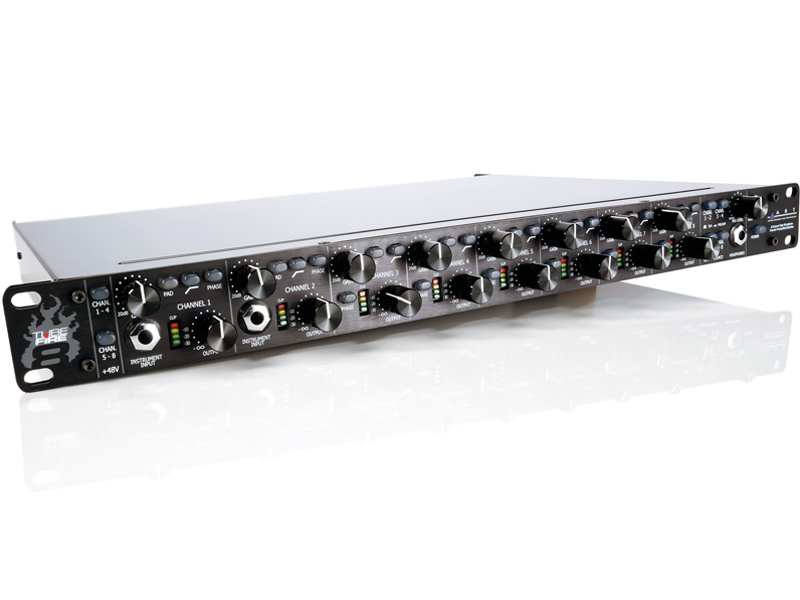MusicRadar Verdict
If you're after quality sound and build rather than tons of clever routing options, the TubeFire 8 is hard to beat for the price.
Pros
- +
Great value. Quality sound. Rugged build. Works as a standalone preamp.
Cons
- -
Basic, hardware-only monitoring. Up against serious competition.
MusicRadar's got your back
The TubeFire 8 packs eight Class-A tube mic preamps inside a 24-bit/96kHz FireWire interface, resulting in a unit that can operate as both a standalone front end and a computer´s I/O solution, with the added bonus of hardware monitoring.
Features include up to 60dB of mic pre gain, 10dB pad, low cut (100Hz, we think - the manual states 80Hz!), phase reverse, LED metering, output level trim (-∞ to +10dB) and phantom power (in banks of four).
You can run up to four TubeFire 8 interfaces in conjunction (although this is limited to two at 96kHz) and all inputs and outputs are balanced. Channels 1 and 2 have the added bonus of a front-panel instrument input jack (with high impedance), and at the right-hand end you´ll see one headphone jack with level control, and switching for the hardware monitoring.
With combi XLR/jack inputs on the back, word clock in and thru, decent headroom (+24dBu using balanced connections) and hardware switching for +4/-10dB operation, the TubeFire 8 feels far more professional than its price tag might indicate. Furthermore, the preamp design is fully analogue, only hitting the A/D converter after the output trim and phase switch.
It´s also worth reiterating that you can run the unit completely independently - ie, without a computer - as a standalone mic pre unit.
Software and monitoring
We´ve long grown accustomed to seeing interfaces - especially those that offer a fair number of channels - coming bundled with controller software.
Not so the TubeFire 8. In fact, the simple applet that we installed on our test Mac only enables you to switch the clocking source from internal to external. All other settings, including sample rate, are handled by OS X´s own audio/MIDI panel or your audio application.
In Windows, the included ART Card Control Panel applet does include a few more options, such as sample rate, buffer size and so on, but neither platform offers any complex software-controlled low-latency monitoring, and that´s because the TubeFire´s monitoring is all hardware-based.
By default, outputs from your computer (ie, the outs in your sequencer) are routed to the corresponding jacks and the headphone feed. The four output source switches enable you to flip these in pairs, routing the inputs directly to the headphones and line outs (these switches have to be engaged to use the unit standalone).
Engaging a switch will ‘kill´ the computer output for those two channels, so you may want to re-jig your sequencer output allocations to make sure they don´t clash with the mic inputs you´re using.
Summary
The TubeFire 8 installs without any problems, clocks properly and sounds great to boot. The build quality is impressive, too - in fact, we feel it´s better than much of the more expensive competition.
There´s no mention of either the tube types used or in what capacity - or of the type of converters inside, for that matter - but the sound is clear and detailed. And with plenty of gain and headroom, it never feels compromised.
Overall, though, this does feel like a mic pre with a FireWire interface bolted on (there isn´t even any MIDI connectivity!). There´s nothing wrong with that, and if simplicity is what you´re after, you´ve got it. However, the TubeFire 8 is nowhere near as flexible as some offerings we´ve seen - such as those from MOTU, RME, PreSonus, et al - and for some users, it might not be quite enough.
MusicRadar is the number one website for music-makers of all kinds, be they guitarists, drummers, keyboard players, DJs or producers...
- GEAR: We help musicians find the best gear with top-ranking gear round-ups and high-quality, authoritative reviews by a wide team of highly experienced experts.
- TIPS: We also provide tuition, from bite-sized tips to advanced work-outs and guidance from recognised musicians and stars.
- STARS: We talk to musicians and stars about their creative processes, and the nuts and bolts of their gear and technique. We give fans an insight into the craft of music-making that no other music website can.
“Delivers streamlined DAW integration with an excellent hammer action keyboard”: Arturia Keylab 88 Mk3 review
“I have an original 909 – every time I try to use it I feel like I’m ruining it”: House hero Riva Starr on his studio essentials and his love of analogue synths
“A synthesizer that is both easy to use and fun to play whilst maintaining a decent degree of programming depth and flexibility”: PWM Mantis review











